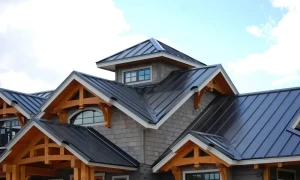
The key to avoiding frequent repairs and unnecessary costs is choosing a roofing material that is built to last. Investing in a roof that can handle cold, rainy climates will not only protect your home but also save you time and money in the long run. Now, let’s explore the best roofing options that offer both durability and performance for homes in these challenging weather conditions. We’ll guide you through the top choices, ensuring you pick the right roof for your needs and environment.
To help you make an informed decision, we’ve compared the top five roofing materials based on key factors such as durability, cost, environmental impact, and weather resistance. These materials are rated with coastal and rainy climates in mind, so you can easily see which option offers the best long-term performance for your home. Below is a detailed comparison to guide your decision.
| Roof Type | Material Durability | Cost ($ per sq ft) | Environmental Friendliness | Weather Suitability | Maintenance | Overall Rating |
|---|---|---|---|---|---|---|
| Metal Roofing | 95 | $9 – $14 | 85 | 95 | 80 | 88.75 |
| Asphalt Shingles | 70 | $2 – $5 | 65 | 75 | 60 | 67.50 |
| Slate Roofing | 90 | $16 – $32 | 90 | 90 | 95 | 91.25 |
| Clay/Concrete Tiles | 85 | $10 – $20 | 80 | 85 | 75 | 81.25 |
| Synthetic Roofing | 80 | $7 – $12 | 75 | 85 | 80 | 80.00 |
- Material Durability: This shows how long each roofing material can withstand cold and rainy climates. Roofs with higher ratings last longer and resist damage from harsh weather conditions better.
- Cost: This column gives a general price range for each material, making it easier to compare the initial investment, though we haven’t assigned a specific rating here.
- Environmental Friendliness: We rated roofs based on their energy efficiency, use of eco-friendly materials, and whether they can be recycled. Higher ratings mean the roof is more sustainable.
- Weather Suitability: Critical for coastal homes. A higher score means the roof is more resistant to water, leaks, and can better handle rain and cold.
- Maintenance: This measures how often each roof needs repairs or upkeep. Roofs with lower maintenance scores are easier to maintain, saving time and money.
Here’s a detailed breakdown for each category, based on additional research:
1. Metal Roofing
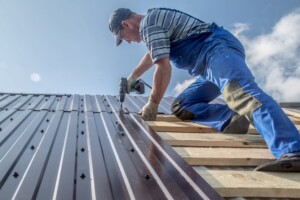
Material Durability: Metal roofing is one of the most durable options, often lasting between 40 to 70 years. Its resilience makes it resistant to shrinking, cracking, and warping, which are common in other materials.
.Cost: Metal roofing is more expensive up front, with prices ranging from $9 to $14 per square foot, but it makes up for it by being low-maintenance and long-lasting.
Environmental Friendliness: Metal roofing is eco-friendly, with many products made from 30-60% recycled materials. At the end of its life, it is fully recyclable, contributing to reduced landfill waste.
Weather Suitability: Metal excels in harsh weather, shedding snow and rain easily while withstanding strong winds up to 160 mph. It’s highly recommended for regions with heavy rainfall.
.Maintenance: Metal roofs require very little maintenance. They may need periodic inspections, but generally, cleaning with water is sufficient.
2. Asphalt Shingles
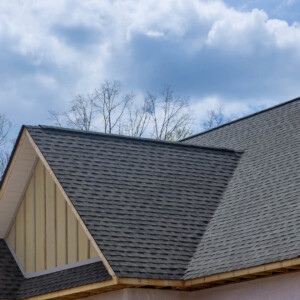
Material Durability: Asphalt shingles typically last 15 to 30 years, but are more susceptible to damage in rain-heavy climates. They are prone to cracking and curling as they age.
Cost: Asphalt shingles are one of the most affordable options, with a price range of $2 to $5 per square foot, making them popular for budget-conscious homeowners.
Environmental Friendliness: Asphalt shingles are not very eco-friendly. They are petroleum-based and contribute significantly to landfill waste when replaced, as they are rarely recycled.
Weather Suitability: While newer models resist moisture better, asphalt shingles are still vulnerable to water damage and less ideal for cold, wet climates.
Maintenance: Asphalt shingles require more frequent maintenance than other materials, with regular inspections needed for leaks, cracks, and potential mould growth
3. Slate Roofing
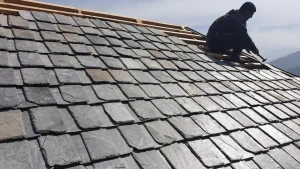
Material Durability: Slate roofing can last over 100 years, making it one of the most durable roofing options. Its natural stone material is highly resistant to rain and freezing conditions.
Cost: Slate is a premium option, with costs ranging from $16 to $32 per square foot. However, its lifespan and minimal maintenance make it a good long-term investment.
Environmental Friendliness: Slate is an environmentally friendly material as it’s natural and has minimal environmental impact during its long life cycle.
Weather Suitability: Slate performs exceptionally well in wet and cold conditions, making it ideal for regions with heavy rainfall.
Maintenance: Maintenance is minimal, but the slate’s weight requires a strong support structure, and professional installation is necessary.
4. Clay/Concrete Tiles
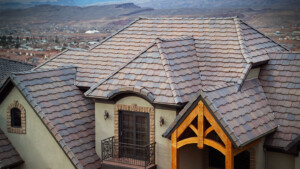
Material Durability: Clay and concrete tiles are highly durable, lasting up to 50 years. They are resistant to most weather conditions but are heavier and more prone to cracking under stress.
Cost: These tiles fall in the mid-to-high cost range, between $10 and $20 per square foot, with the initial investment offset by their long lifespan.
Environmental Friendliness: Both clay and concrete are natural materials, making them eco-friendly options. However, the energy used in their production is a drawback.
Weather Suitability: Clay and concrete tiles handle rain and cold well but are heavy, require strong support, and can crack under extreme weather conditions.
Maintenance: They require moderate maintenance to prevent cracking, and periodic inspections are necessary to ensure structural integrity.
5. Synthetic Roofing Materials
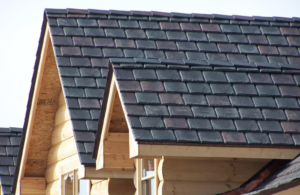
Material Durability: Synthetic roofing materials, such as composite slate or shake, offer durability with a lifespan of around 30 to 50 years. They are designed to mimic natural materials but with improved resilience.
Cost: Synthetic materials are less expensive than natural stone or slate, ranging from $7 to $12 per square foot, offering a good balance between cost and performance.
Environmental Friendliness: Many synthetic options are made from recycled materials, making them eco-friendly. However, they are not as natural as slate or clay.
Weather Suitability: These materials are well-suited for all weather conditions, including heavy rain and cold, with ratings comparable to their natural counterparts.
Maintenance: Synthetic roofs require low maintenance, needing only periodic checks for wear and tear.
Your roof is more than just protection—it’s an investment in your home’s future. For homeowners in coastal and rainy climates, choosing the right roofing material is key to avoiding costly repairs, frequent maintenance, and unnecessary stress. Whether you’re looking for long-term durability with metal roofing or affordable protection with asphalt shingles, it’s crucial to select a roof built to withstand harsh weather conditions.
Don’t wait until the next storm hits! Contact us today to discuss the best roofing options for your home. Let us help you protect what matters most, ensuring your roof lasts for years to come, even in the toughest environments. Whether you’re planning a new installation or need a replacement, our expert team is here to guide you every step of the way. Secure your home’s future now with the right roofing solution.


